Looking for the best webinar software platforms of 2024? After spending many years hosting and attending webinars and online conferences, I have come up with a list of the 24 best webinar software to try in 2024.
Webinars have replaced in-person events and seminars in the past year as the Covid-19 situation got worse across the globe. According to Global Webinar Statistics, nearly 75% of businesses depend on webinars to generate leads when it comes to B2B. For B2C, the number is somewhere between 70% to 77%.

Choosing a proper online webinar platform is difficult sometimes as things can go wrong anytime during the webinar. Weak network, download issue, unclear audio, non-HD video, and whatnot. While selecting a webinar hosting platform, make sure to consider the following points,
- Is it fulfilling your requirements?
- How satisfied are you with the audio and video quality?
- How many participants can join your webinar?
- How complicated the plugins are for the attendees?
- How cranky downloads and extensions are?
You keep digging your head into these complicated questions before hosting a webinar. I made it a little easier for you by sharing the pros and cons along with the main features of the best webinar tools in 2024.
In my personal opinion, Demio is an excellent webinar tool to use. You can call it an industry leader when it comes to streaming capabilities. Another awesome tool is WebinarJam that has more than just standard features. I frequently use these two tools. Before you proceed with my list of best platforms, here are the top ones I picked.
Webinar Software | Top Features | Our Rating & Special Link |
#1 Webinar Software |
| |
| ||
| ||
|
Let’s look at the list of the most popular webinar software that marketers use to host a virtual event, their pros and cons, and pricing plans. Then click on each one to check out the details see for yourself which is the best value for money.
On this page, you’ll learn about the following:
What is the Best Webinar Software Platform of 2024?
Here are the top picks for the best webinar software platforms to try in 2024.
- Demio
- WebinarJam
- EverWebinar
- Livestorm
- Crowdcast
- Livestream
- WebinarsOnAir
- DaCast
- Zoom
- Adobe Connect
- WebinarNinja
- GoToWebinar
1. Demio
The Best Webinar Software Platform for marketing & lead generation
Demio excellently combines no-download webinars for audiences and marketing tools for lead generation. It delivers real-time HD streaming video with an aesthetically appealing platform. You can customize nearly everything to match your brand.
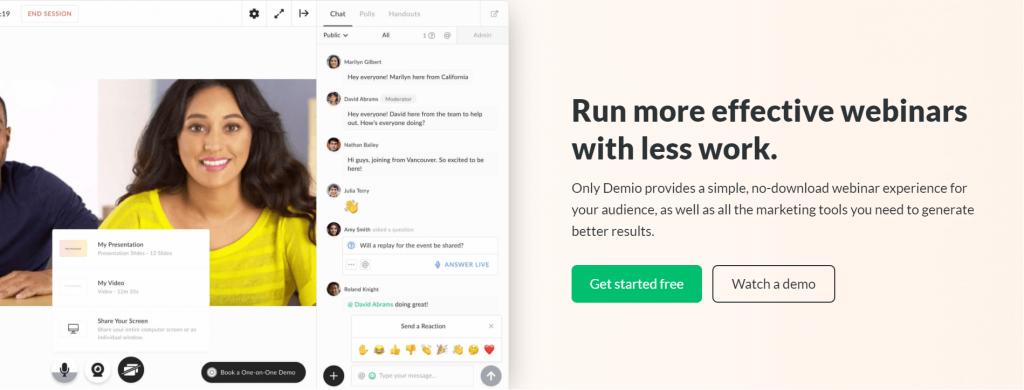
Pros
- Automatic, cloud-based events and recordings
- Chats, handouts, and polls with enjoyable waiting room experience
- Built-in robust analytics and insights
- Easy-to-integrate marketing tools
- Email automation plus event reminders
Cons
- Price is on the higher end for more than 50 live participants.
- No registration page conversion analytics, so it cannot be determined how many did not register, for instance.
Price
- A 14-day free trial lets you test key features.
- Starter Plan costs $499/year for a 50-person room
- Growth Plan costs $899/year for a 150-person room with customized branding
- Premium Plan costs $2,200/year for a 150-person room plus 4 hosts
- Unlimited Plan costs $22k/year for a 150-person room plus unlimited hosts
2. WebinarJam
Budget-friendly Webinar Software for all the Virtual Meetings (14-day trial at $1)
WebinarJam is the best webinar hosting platform for you if you have little to no technical knowledge about virtual meetings. It is an easy-to-use webinar platform! You will get a 14-day trial by spending only $1.
It lets you stream directly to a YouTube page. Plus, it has a secure, password-protected meeting.
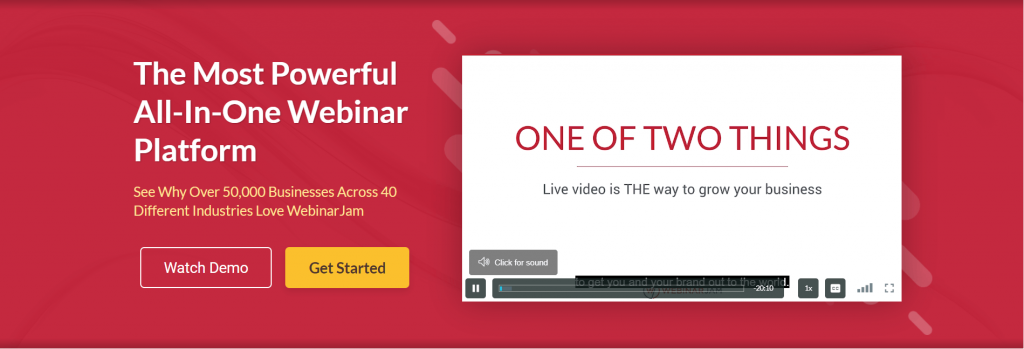
Pros
- Automatic recording
- Excellent customer support
- Built-in autoresponder
- Social media integrations like Facebook
- Handle multiple attendees easily
- Compatible with various browsers and OS
- Incorporate polls and surveys with webinar
- User-friendly dashboard and interface
- It only takes 60 seconds to set up and run
- Shows pop-ups alerting attendees to buy a product or service right from the webinar
- Allo two-way communication with Live Chat that pulls a video of a participant for 1:1 communication
Cons
- Needs purchase of EverWebinar for automated on-demand webinars
- Occasionally video and sound delay up to a couple of seconds
- Lacking integration with third-party AV tools
Price
- A 14-day trial for $1
- Starter Plan costs $39/month (billed annually) for up to 100 participants per webinar for 1 host and 1-hour duration (max).
- Basic Plan costs $79/month for up to 500 participants per webinar and 2 presenters.
- Professional Plan costs $229/month for up to 2,000 participants and 4 presenters.
- Enterprise Plan costs $379/month for up to 5,000 participants and 6 presenters.
3. EverWebinar
Powerful solution trusted by major brands.
EverWebinar is among the popular tools built directly into WebinarJam but sold separately or in a bundle. EverWebinar is ideal for small and medium businesses aiming to generate leads and boost sales through virtual events. It is trusted by big brands like AppSumo, Podia, and the likes.
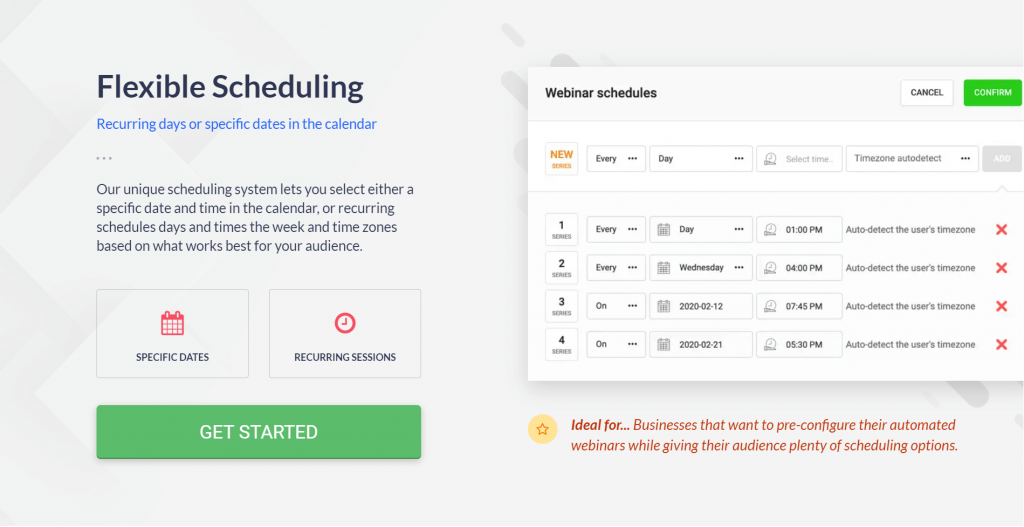
Pros
- Switch between WebinarJam and EverWebinar in one click
- Fake your audience count
- Show performance stats in real-time
- Convert previous live events to evergreen events
- Just-in-time online events start right upon registration
- An advanced scheduling system that blocks out unavailable dates
- Auto-detection of time zone
- Unlimited free hosting through cloud-based servers
Cons
- A few complaints about streaming on mobile
Pricing
- 14-day free trial
- 30-day money-back guarantee
- Annual Plan $499/year
- Biennial Plan $874/2 years
4. Livestorm
Best for product demos & sales
Livestorm is one of the ideal webinar software platforms for product demos and sales. It works on any browser and has no restrictions on webinar size. More importantly, it is accessible from any device—PC, tablet, or mobile phone.
Its promotional email logistics allow you to send promotional emails, automate emails, check email notifications, and personalize them. It makes customer engagement content with polls, Q&A sessions, and up-votes.
Participants also don’t need to register or create a specific account. They can join with one click.
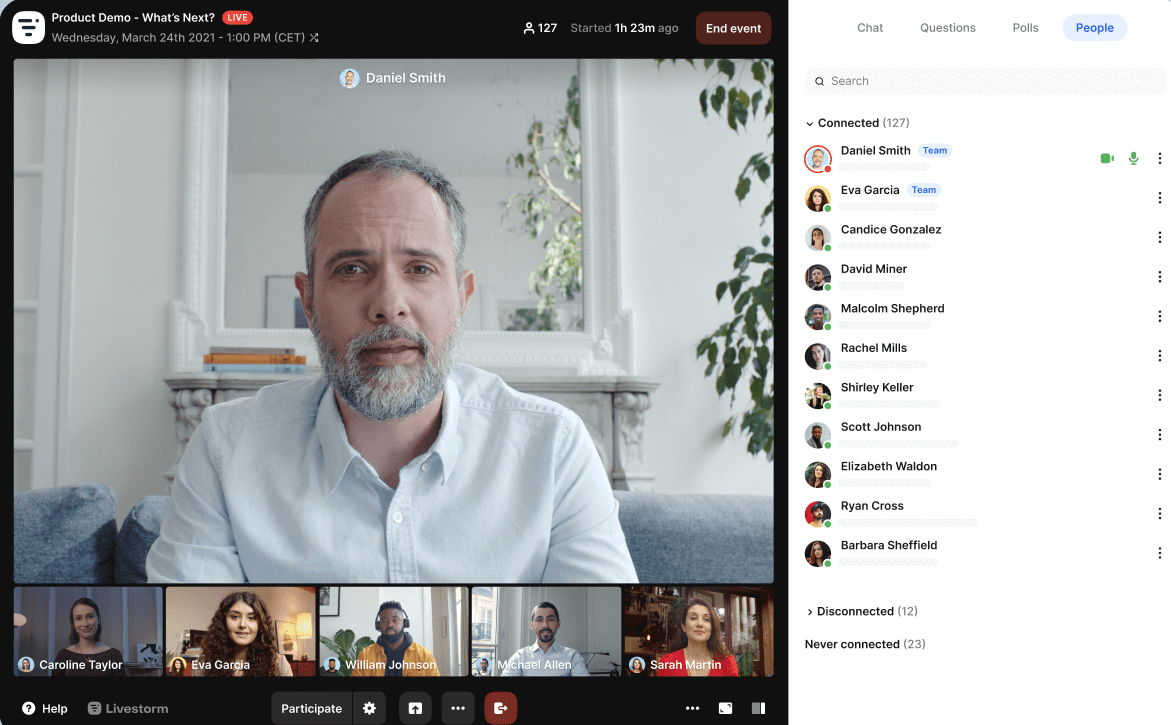
Pros
- Access easy to set-up adaptable webinar themes
- Interactive experience with chats, polls, questions, and more
- 1:1 meetings with qualified leads
- Integration and analysis of meetings
- High-level automation and webinar sequences
- Comprehensive, multi-language customer support.
- One-click invitation, screen-sharing, and embed registration forms, among others
- Free Plan with essential features
- Detailed attendance analytics, source tracking, replay analytics, and participation report
- Unlimited storage of recording
- Export data as CSV or XLS
- Display in-webinar CTAs
- Use Zapier and integrate with over 1,000 apps
Cons
- Occasional blurry and pixelated display
- Spotty customer support at times
- No offers on replay; offers done on live are lost on replay
- There’s no way to re-open pop-ups
Pricing
- Basic Plan is a free plan ($0) for unlimited time with essential features (unlimited on-demand webinars, meetings, etc.), up to 30 live attendees, and 20 minutes+ per session.
- Pro Plan costs $79/month billed annually and $99/month billed monthly. This plan allows up to 4-hours per session and up to 100 live attendees.
- Business Plan offers up to 500+ active contacts per month. Upto 3000 live attendees. You can request for quote as per your requirement.
- Enterprise offers managing multiple workspaces with unified billing, premium training, and SLA, up to 12+ hours per session, and 3000+ live attendees. You can have a personalized quote per your requirements.
5. Crowdcast
Marries webinars, live streams, and social media.
Crowdcast is a live streaming platform for webinars, Q&As, courses, concerts, and online conferences. If you’re new to live to stream and want to get started quickly and easily, then Crowdcast is for you. With this software, you can just start your first live stream in mere minutes even if you are not a very techy person. It is also deemed to be a combination of webinars and live streaming with a social media aspect to it.
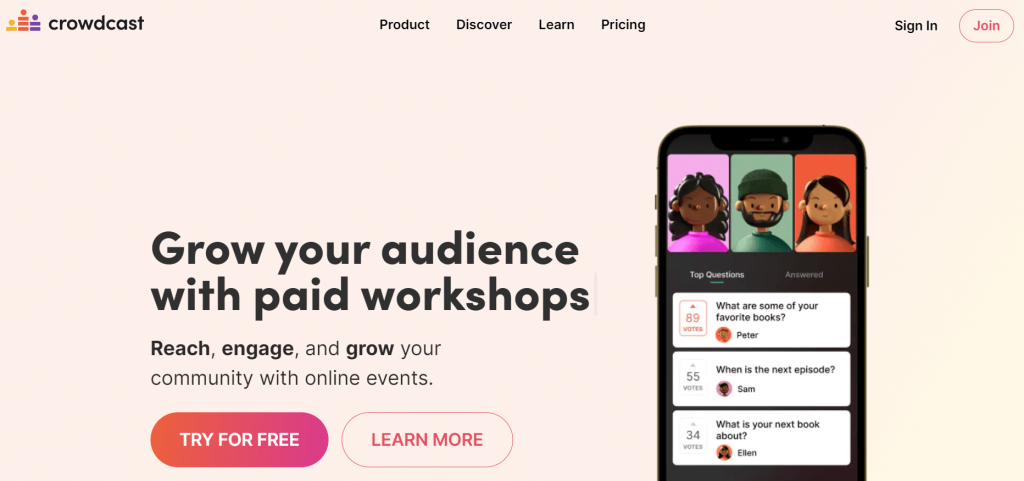
Pros
- Easy to get started
- Browser-based (no downloads)
- Go live or attend on any device
- Has a separate tab for public chat and for asking questions.
- Easy invite feature
- Presenters can multi-stream on Facebook and Youtube.
- Very interactive (Polls, Analytics, Question & Answer)
- A good option for people who are new in marketing or live streaming.
- The audience can chat and ask questions even before the live starts.
- Can be used together with streaming software.(OBS, Wirecast, etc.)
- Has a Preview page before going live.
- Has a social network aspect wherein people can have their own accounts and follow presenters and see past, ongoing, and future events.
- Email and push notifications
Cons
- The landing page for the audience is not very customizable
- Sessions have a limit of 2 hours for starter plans
- No multi-user access
- Some features are locked on expensive plans.
Pricing
- Lite Plan costs $34/month billed annually
- Pro Plan costs $62/month billed annually
- Business Plan costs $136/month billed annually
6. Livestream
Trusted by educational institutions.
Livestream primarily caters to big businesses and educational institutes with already engaged and built relationships with their target audience. Also, you can have as many attendees as you need since there’s no max limit. That is on top of unlimited storage and automatic recording and storing any type of webinar you have in the cloud.
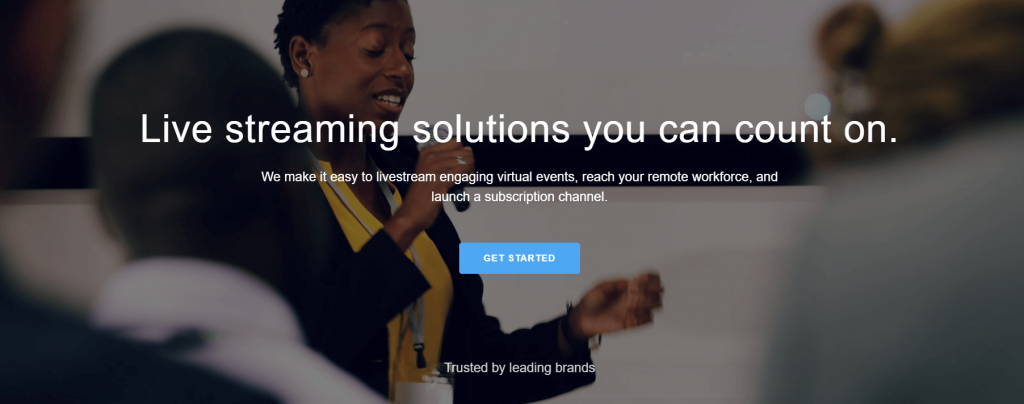
Pros
- Unlimited storage and attendees
- Excellent customer support
- Privatization of events
- Private sharing of link
- Extensive in-built robust analytics
- Facebook Live or YouTube streaming
- Embed webinar to website
Cons
- No audience engagement features such as surveys or polls
Pricing
- Free 30-day trial
- At $42/month, there’s no limit to participants
- Premium plant costs $199/month and includes robust analytics tools and a live embedding option.
- Enterprise clients cost $799/month and have advanced options like password protection, advanced features for privacy controls, and more.
7. WebinarsOnAir
Best for mid-tier seminars.
If you are after affordability, WebinarsOnAir is perfect for you. It even comes with all the essential features necessary to host any type of webinar excellently. It is also user-friendly for both hosts and participants.

Pros
- Schedule webinar for up to 50,000 attendees in under a minute
- Use “Tracking Pixels” to create “laser-targeted audiences for retargeting”
- Live Q&A with live-chats
- Allows 10 moderators or speakers at once
- Easy webinar registration
- in-built opt-in forms
- Cloud-based hosting
- strong customer service
Cons
- Dependent on Hangouts and may become inaccessible due to changes in Google software
Pricing
- 30-day free trial
- $19.97/month for 25 viewer
- $99/month for unlimited participants
8. DaCast
Best for mid-tier seminars.
DaCast allows easy set up of an online environment for virtual conferences in minutes. It also offers impressive broadcasting features for easy webinar management, monetization, and online video analysis.
Popular features include integrating live video with APIs and video streaming over social media platforms like Facebook and YouTube, allowing you to shoot live online meetings and on-demand webinars at a later date.
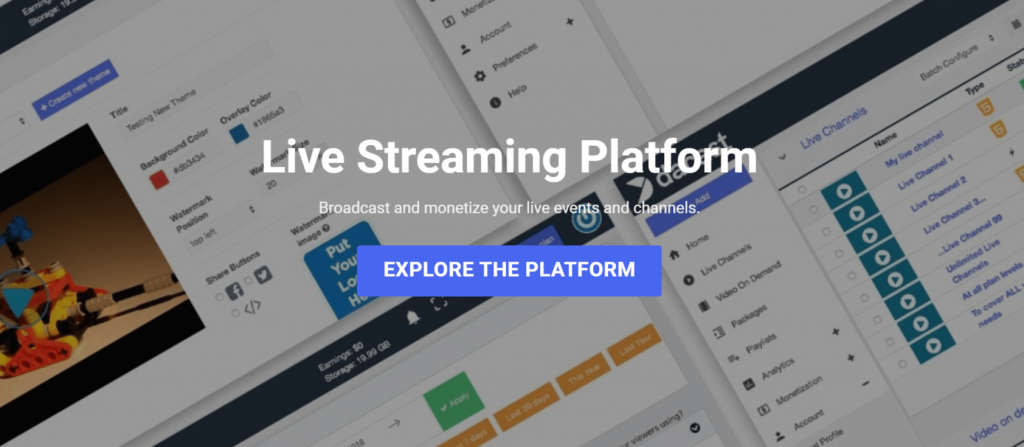
Pros
- No viewer limit
- Real-time robust analytics
- Allows FTP access
- Live stream on social media platforms like Facebook
- An interactive video on demand (VOD) solution
- Easy to set up
- User-friendly web conferencing interface
- strong customer service
Cons
- $0.15 charge per GB beyond the bandwidth amount or streams will shut off
Pricing
- Free trial
- Per-event Plan starts at $0.25/GB
- The monthly plan starts at $19/month and includes prepaid bandwidth, viewer hours, storage, and support
Other Webinar Software to Try
This list of other webinar software is also worth trying. Remember, it’s all a matter of what you need and how much you are willing to spend. Let this list help you decide.
9. Zoom
Today’s most popular platform to connect with friends and colleagues.
Zoom is intuitive, entirely cloud-based, and has a user-friendly interface that makes things simpler. There are various available HD video and audio, screen sharing, and app sharing options. You can also host scheduled and unscheduled meetings and keep a backup of every session. There is also an option for private and public chats.
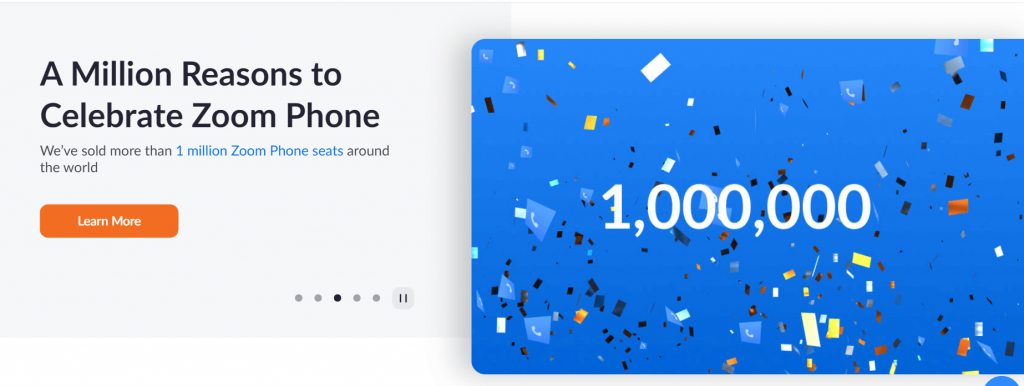
Pros
- HD video and audio plus screens sharing
- Desktop and app sharing options
- Backup meetings in the cloud
- Private and public chats, allowing participants to communicate during webinar interruption
- Free access to up to 100 participants with 40 mins limit on group meetings
- Host controls and virtual whiteboards
- Easily navigable dashboard.
- No one-time fees
- Free sign up
Cons
- The navigating interface can be quite confusing
- There are complaints of calls being disconnected
Pricing
- Free Plan for a 40-minute webinar of up to 100 participants
- The basic program is $14.99/month with 1 GB of cloud recording
- The business package is $19.99/month and is ideal for small and medium-sized businesses
- The enterprise package is $19.99/month and suits large enterprises
10. Adobe Connect
Ideal for massive marketing organizations, larger companies, and even for town halls.
Adobe Connect webinars, apart from letting you host videos and meetings, also share documents. You can also customize your hosting room and optimize it per your requirement. It also helps showcase products and services to their target audience.
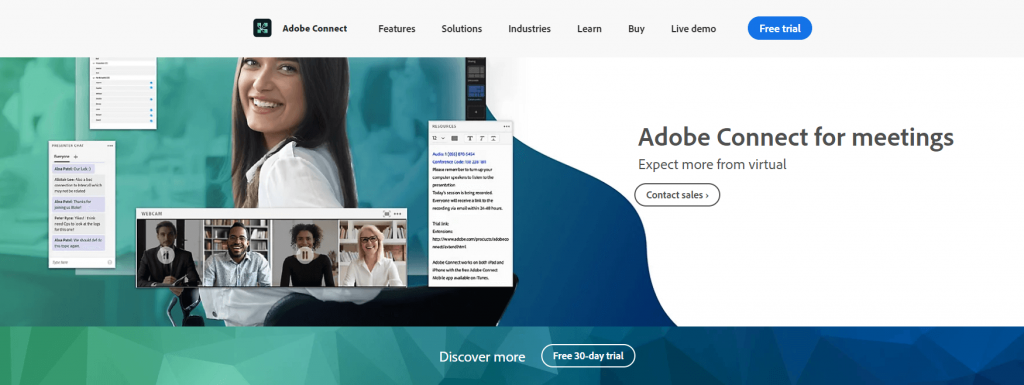
Pros
- Various templates to customize for virtual environments.
- Create unique registration pages
- Reach out to target audience using videos, blogs, surveys, and polls.
- Detailed adobe analytics for better insights
- Integrates with CRM software such as Eloqua and Salesforce.
Cons
- There are reports of some video and audio disturbances on mobile.
Pricing
- 30-day free trial
- Meeting Plan starts at $50/month for 25 participants and up to 200 participants for the Learning plan.
- Webinar tier 1 is $130/month for 100 seats
- Webinar tier 2 is $470/month for 500 seats
- Webinar tier 3 is $580/month for 1,000 seats
11. WebinarNinja
An all-in-one solution.
WebinarNinja is a powerful, all-in-one, and straightforward solution that allows you to create a webinar in under a minute. It offers four different types of webinars: live, automated, series, and hybrid.
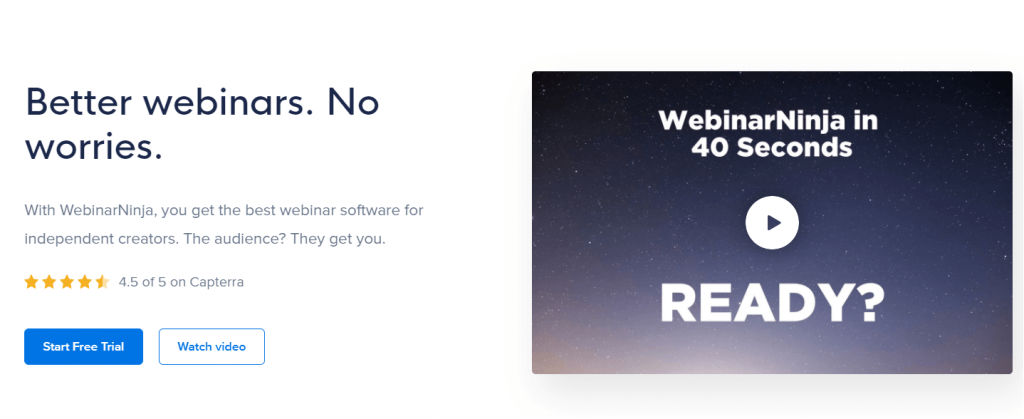
Pros
- Superfast live chat
- Instant screen sharing
- Multiple polls running before, during, and after the webinar
- Display timed offers any time during your webinar
- Email automation plus drip campaigns
- High-conversion and custom-registration landing page
- Analytics dashboard that allows export of data
- Integration with over 1,000 apps with Zapier
Cons
- The back-end is challenging to navigate
- Occasional glitches with audio
- Longer upload of extended presentations
- Slow customer service
Pricing
- 14-day free trial to test features.
- Starter Plan is $39/month and allows 100 webinar attendees
- Pro Plan is $79/month and allows another 200 webinar attendees
- Plus Plan is $129/month for 500 webinar attendees.
- Power Plan is $199/month for 1000 webinar attendees.
12. GoToWebinar
Trusted web conferencing software by big organizations.
GoToWebinar makes organizing webinars easy as you focus on reaching more people and growing your business. Choose the date for your webinar, and the platform takes care of everything else.

Pros
- Pre-recorded events
- Detailed analytics
- HD video quality
- Round-the-clock customer support
- Integration with GoToMeeting
- In-built polls and surveys for audience engagement
- Automatic recording shareable online
- Integration with Zapier, Salesforce, Unbounce, among many others
- Source tracking that shows the channel with maximum webinar sign-ups
Cons
- Pricey with basic version costing up to $900/year
- Basic version allows only 100 attendees in a webinar
- Outdated software
- Unreliable customer service
- Participants and presenters must download certain software to use the platform
- Manual uploading of the recorded file to the cloud
Price
- 7-day free trial
- Starter plan costs $89/month for 100 participants
- $199/month for 500 participants
- $429/month for 1,000 participants
Note: all for annual subscriptions, and no credit card is required.
13. LiveWebinar
Trusted in live streaming.
The live webinar is a cloud-based webinar tool that can host over 1000 participants. It also has over 42 data centers and over 99% SLA.
There’s no need to download and install the application to join and conduct online meets. You can do it directly from your internet browser. You can also embed any type of webinar into your website.
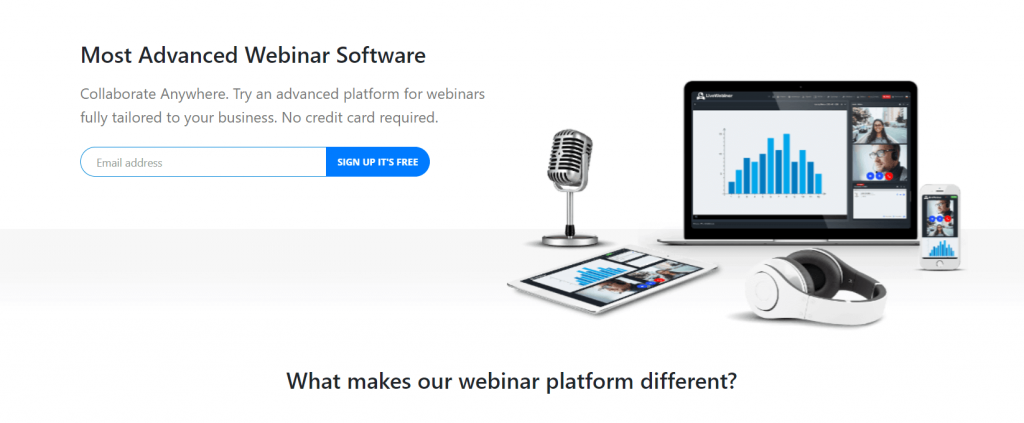
Pros
- WhiteBoard allows drawing on documents, thus more straightforward expression of ideas
- Invite viewers to draw as well
- Add Prezi forms to online events.
- Split the main room into smaller break-out rooms even during live meetings
- Host up to 1000 attendees
- All pricing plans have a 14-days free trial
- Embed banner ads into an online meeting
- Translates chats real-time into a preferred language
- Include tests, surveys, and polls during the webinar
- Play YouTube video in webinar rooms
Cons
- Steep learning curve for a first-time user
- Issues when upgrading services
- UI is a bit complicated
Pricing
- Free allows up to 5 attendees
- Pro is $11.99/month for up to 100 attendees
- Business is $95.20/month for up to 500 attendees
- Custom has custom pricing plans for over 1000 attendees
14. BlueJeans
Ideal for Big Virtual Events.
BlueJeans is an excellent video conferencing tool offering different products, such as BlueJeans Events, which allows webinar hosting, or BlueJeans events hosting for large global audiences. It can host up to 50,000 attendees.
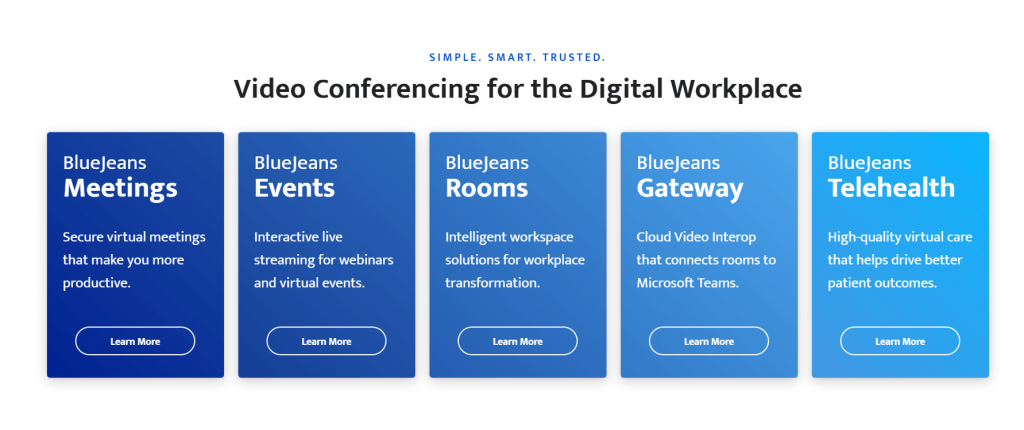
Pros
- Allows global BlueJeans events with 50,000 attendees and 150 presenters
- Cloud recording of the event
- Manage event with easy moderator controls
- No need to download the app
- Works from any device
- Live stream to Facebook Live or YouTube
- Post-event analytics reports
- A/V equipment recommendations and specs
- Round-the-clock premium support
Cons
- Relatively pricey
Pricing
- 14-day free trial
- Starts at $99/month for 100, 200, and 500 participant breakdown
- Contact sales for more extensive presentations of up to 50,000 attendees
15. MyOwnConference
Ideal for multiple-webinar scheduling.
MyOwnConference lets you connect with your audience before, during, and after the webinar and offers a schedule view for you to see multiple webinars in one place. Ideal when looking for a cheap team collaboration tool for multi-presenter options for virtual meetings of a small audience.

Pros
- Record video in full HD
- Send recorded meeting to attendees
- Excellent video conferencing and screen sharing for teams
- Instant messaging during an online session
- No download needed for attendees
- Share YouTube videos or other videos during the broadcast
- Online quizzes
- White label solution for agencies and brands
- Available in 16 languages
Cons
- UI is not very user-friendly
- The live room layout seems clunky
- Internet connection affects webinar performance
Pricing
- Free up to 20 attendees and 3 broadcasters with 500 MB of storage plus standard HD quality.
- Paid plans are based on the number of attendees. Sample: $30/month for 60 attendees, $51/month for 150, and $250/month for 1,000.
16. EasyWebinar
The ultimately user-friendly webinar software tool.
EasyWebinar integrates webinar technology with marketing strategy successfully. It provides an all-in-one solution for live and automated hybrid webinars.
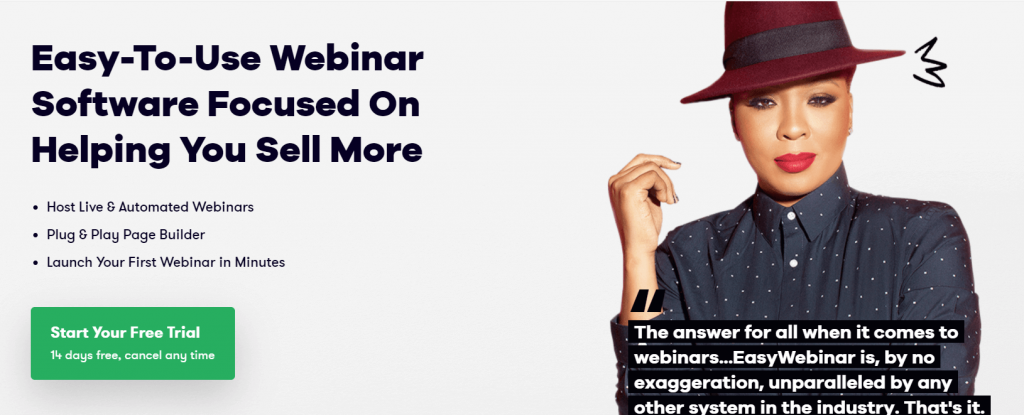
Pros
- Screen-sharing of HD video
- Interactive live chat
- Up to 100 attendees even for basic Plan
- Integration to YouTube Live for unlimited live viewers
- Available chat features and mobile app
- WordPress integration
- In-built analytics
- Integration with popular tools like MailChimp, GetResponse, among others
Cons
- Relatively more expensive
- Requires mobile users to download the app before they can join a webinar
Pricing
- The standard package costs $59/month billed annually at $708
- Pro plan costs $90/month
- Enterprise plan costs $349/month
- For over 10,000 attendees, get in touch with them for quotes
17. ClickMeeting
Outstanding education features.
ClickMeeting has an impressively user-friendly interface, making it easier for you to reach out to your customers. It is well-integrated and intuitive, with options for automated online meetings and customized invites. ClickMeeting is ideal for small and medium-sized businesses.
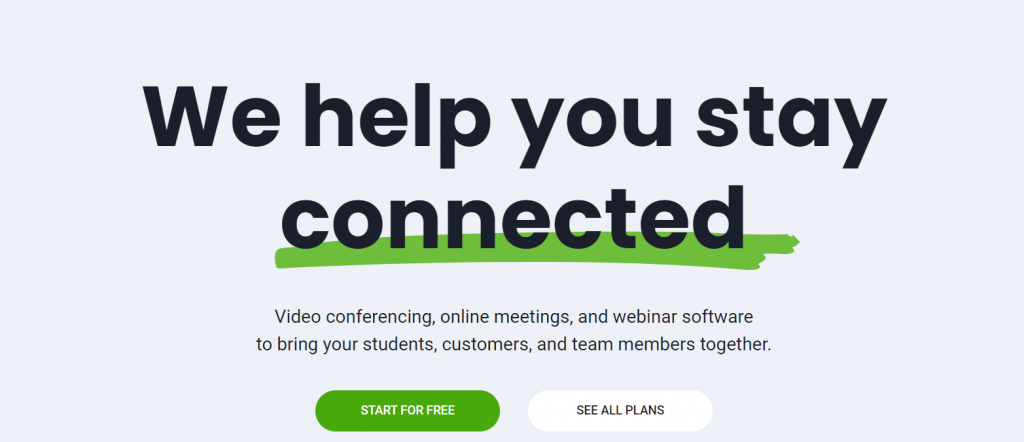
Pros
- Polls and surveys for feedback
- Chat and interactive sessions
- Connection to Facebook Live and YouTube for enhances engagement
- Recording of entire audio and video of live sessions
- Recordings are stored in the cloud and easily downloadable
- HD video presentation for multiple presenters
Cons
- Cannot schedule recurring meetings
- No break-out sessions
Pricing
- 30-day free trial
- $25/month billed annually for 25 attendees
- $35/month billed annually for up to 50 attendees
- Custom-pricing for enterprises
18. BigMarker
Highly interactive and best for summits.
BigMarker allows engagement of up to 10,000 people at once with no limits on the number of presenters. Anyone can join the discussion on screen. As a host, you get a suite of marketing automation tools.
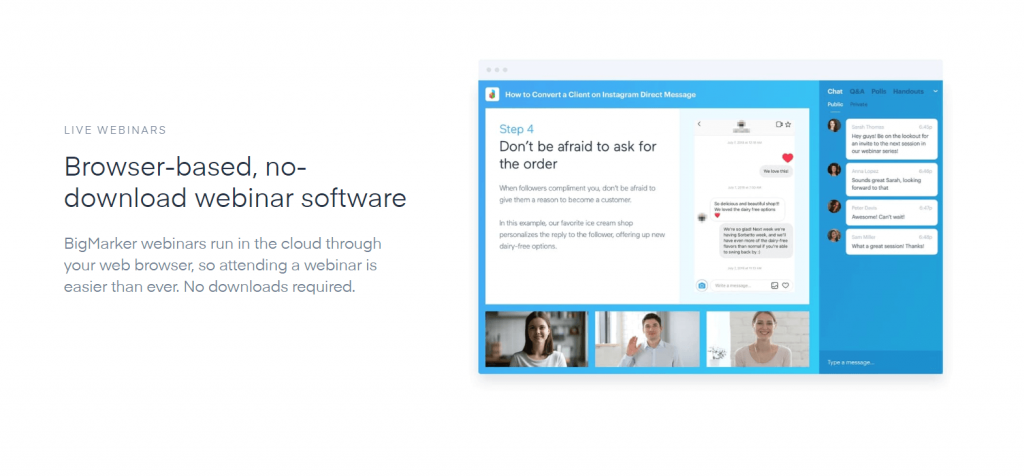
Pros
- Unique live streaming features
- Extensive integrations with apps like Salesforce, Hubspot, Zapier, among others
- HD video and screen sharing
- Stream multiple cameras feeds to Facebook and YouTube Live
- Custom live video experience for online events
- White-labelled seminar rooms and landing pages
- Over 15 different landing page types
- Deal in over 135 currencies.
- Industry-standard SSL and HTTPS encryption
Cons
- May experience dodgy contact and stalled sessions if running on a slow connection
- Challenging to set up the required webinar type given the many features
Pricing
- 7-day free trial
- The starter option is $79/month for 100 attendees and 1 host.
- Elite is $159/month for 500 attendees and 2 hosts.
- Premier is $299/month for 1000 attendees and 4 hosts.
- White-label can be customized and is ideal for large events of up to 10,000 attendees
19. GetResponse
Ideal when integrating email marketing.
GetResponse is primarily an email marketing platform, but it offers various online marketing solutions like a webinar platform. It allows a 3-minute seminar setup.
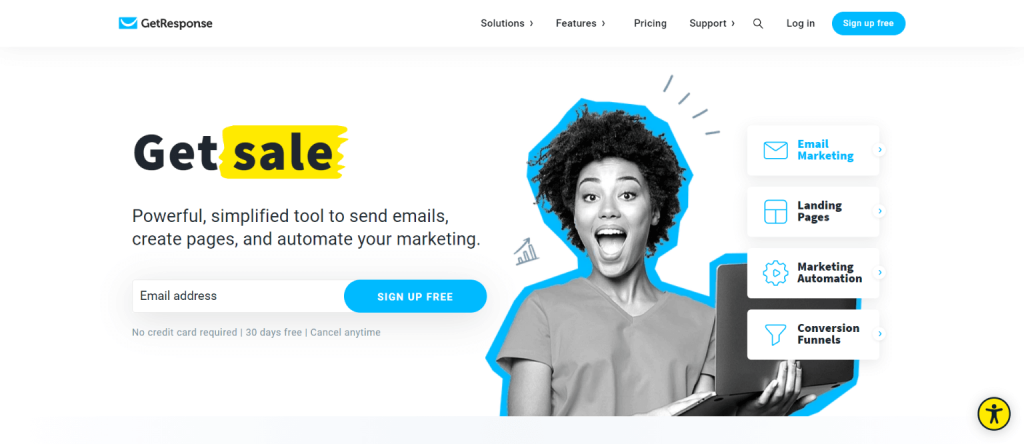
Pros
- Customization of webinar URL.
- Invitation and email notification templates for a pre-existing webinar including pre-filled webinar details
- Webinar recording in one click
- Text chat feature for engagement
- One-click sharing option
- Set up autoresponders
- Tracks conversions with detailed audience statistics
Cons
- Confusing pricing structure
- A limited number of s subscribers you can send messages to for a free trial
- No available phone support
Pricing
- 30-day free trial
- Basic Plan doesn’t include webinar features
- Plus Plan provides webinar solutions and starts at $49/month for up to 100 attendees
- Professional Plan is $99/month for up to 300 attendees.
- Enterprise is $1,199 for up to 500 people; it includes email campaign consulting and a dedicated account manager.
20. AnyMeeting
User-friendly and intuitive, ideal for startups.
AnyMeeting is ideal for small organizations, startups, and educational institutions. It offers essential tools to host your webinar, along with a user-friendly and intuitive interface. It also provides web conferencing tools to conduct collaborative sessions with team members, prospects, and clients.

Pros
- Up to 6 live speakers plus up to 1,000 participants
- Real-time audience chat
- In-built Q&A sessions, live-chat, surveys, and polls for audience engagement
- Custom email invites and follows up of attendees
- User-friendly and intuitive interface
- Detailed analytics and built-in reporting
Cons
- Relatively pricey
- Does not allow broadcasting from mobile devices
Pricing
- Webinar Lite is $48/month for 50 viewers.
- Webinar Pro is $128/month for up to 200 viewers.
- Webinar Enterprise $298/month for up to 1,000 people
21. Webex
HD video and audio services are accessible on multiple devices.
Webex provides impressive features, such as a host room and HD video and audio services accessible on multiple devices. It allows users a high degree of customization to tailor the host environment, thus suiting business requirements.
It is a cloud-based platform, so there’s a guarantee of data security along with superior speed.
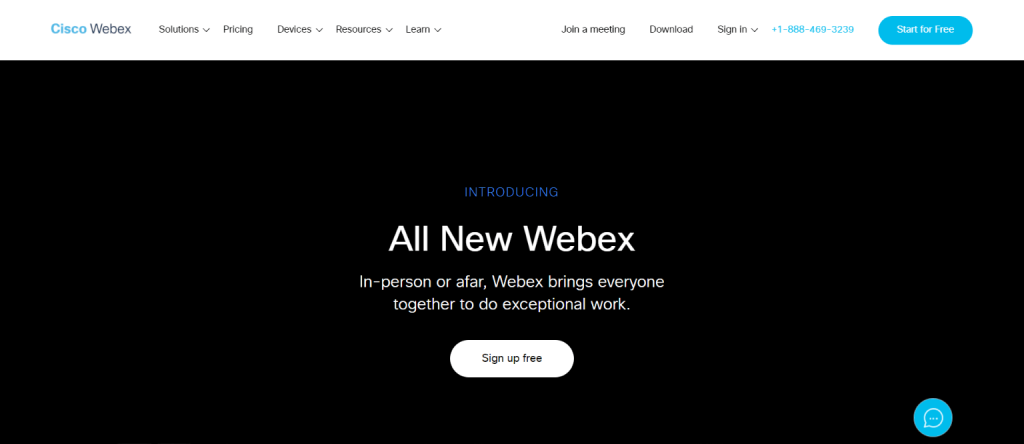
Pros
- Cloud-based platform
- Host up to 40,000 attendees
- Built-in Q&A sessions, surveys, and polls for audience engagement
- Provides a mobile app
- Integrates with popular marketing tools like Salesforce
Cons
- Not quite suitable for consumer virtual events
- More suitable for in-house team collaboration
Pricing
- Basic Plan costs $13.5/month for up to 50 participants if billed annually.
- Price climbs up as you move further up to a higher-tier
22. Zoho Meet
Simple and user-friendly.
Zoho Meeting is easy to use and ideal for both small and large businesses. Also ideal for essential remote support, team collaboration, application-based demonstrations, and meetings.
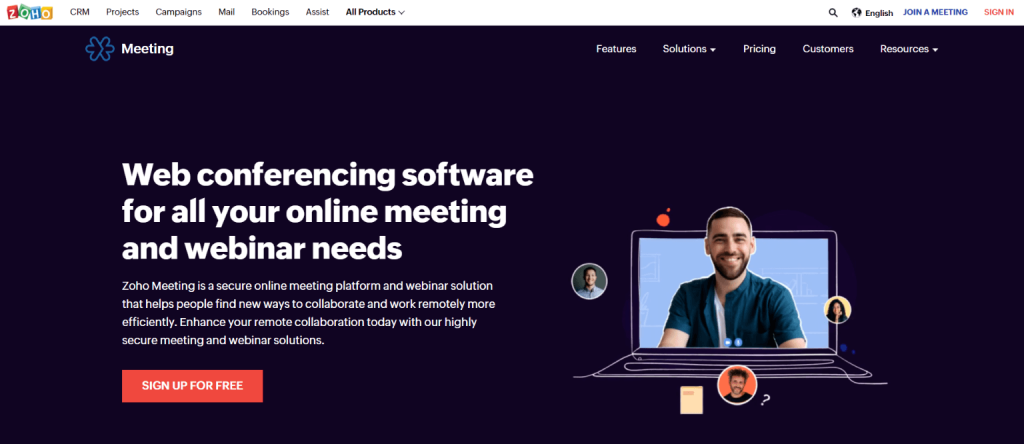
Pros
- No need to download it; it runs directly
- Allows screen sharing, moderator controls, and live chat
- Q&A, polling, broadcast messages set attendees as a presenter, an attendee can “raise a hand.” and speak
- Online recordings shareable and downloadable
- Embed registration form on the website for visitors to join meeting in one click
Cons
- Reporting is not in-depth
- Features are simple and basic
Pricing
- Free version with unlimited meetings up to 2 participants and unlimited online meetings capped at 10 attendees
- Paid meeting starts $10/month with up to 100 participants
- The paid webinar starts at $19/month for 25 attendees
23. WebinarGeek
Easy to set up & best for marketing.
WebinarGeek is an easy-to-use and straightforward webinar software. User-friendly for the marketers, the developers claim this tool to be the simplest to use. Also, it does not require any downloading. Hence, the non-complexity of this software makes it everyone’s favorite.
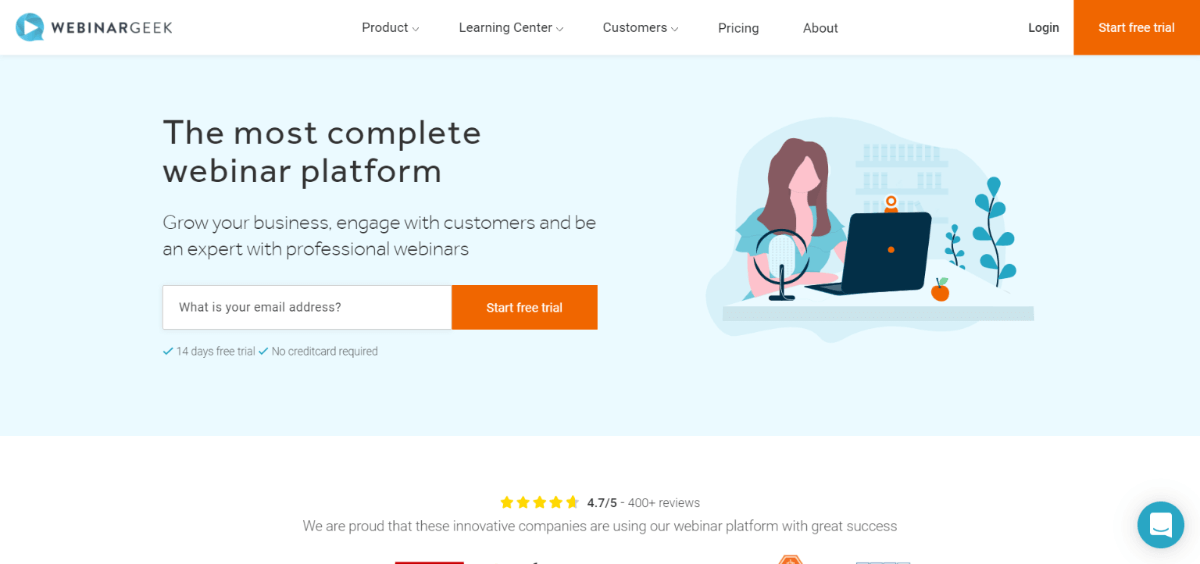
Pros
- Easy to set up.
- Best for marketing.
- The premium plan has a personal branding feature.
- You can add speaker notes while doing the webinar.
Cons
- It takes time to set up.
- No chat support on weekends.
- You cannot send customized emails to your viewers/non-viewers.
- There is no way to know if the receiver opened the email or not.
Pricing
- 14-day free trial.
- Starter Pack – $26.91 per month, billed annually.
- Premium Pack – $55.23 per month, billed annually.
- No Credit Card is required.
24. Webinar.net
It is cloud-based hosting.
Webinar.net has launched in the year 2019. It is the first-ever cloud-based tool that does not need to count the capacity. A host can reach out to a massive audience via cloud-based hosting.
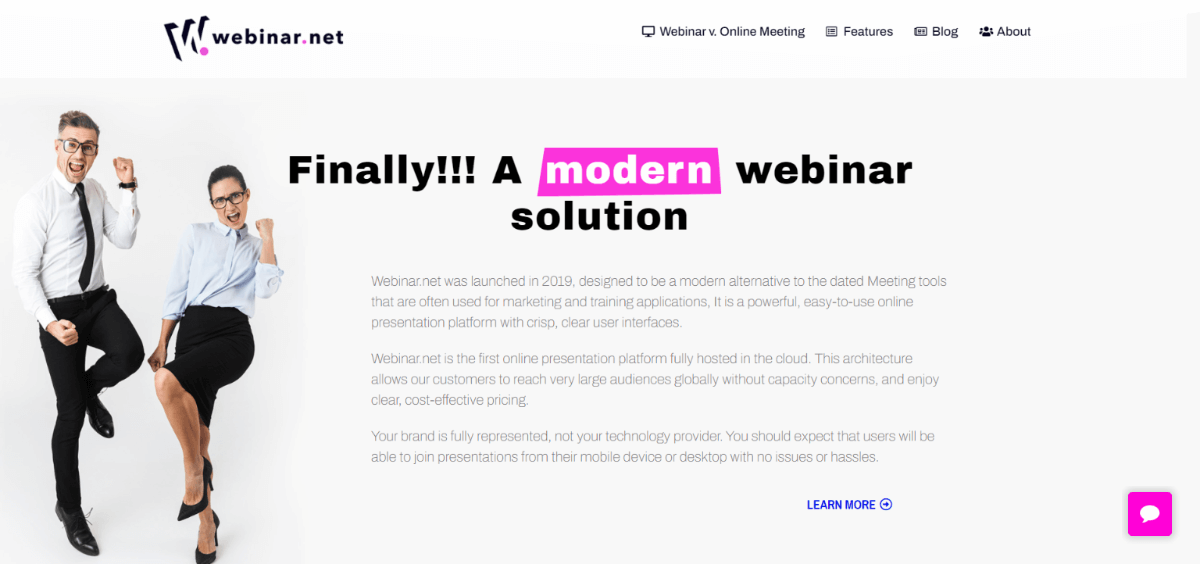
Pros
- It is a cloud-based tool.
- Hosting takes place via the cloud.
- No capacity concerns
- Reach out to massive audiences
Cons
- The speaker does not do well sometimes.
- It is a bit expensive when it comes to licenses.
- It takes more time to load
- Sometimes the server does not work, which results in a bad connection.
Pricing
- Free trial is available.
- $500 per month for the entry-level package
What Is a Webinar Software?
A webinar mainly comes from the words web and seminar. It is an interactive live online event that can also be recorded. The hosts deliver a presentation on a specific topic to people connected to that event through the internet.
Webinar platforms manage this online video conference meeting, usually as a lecture, seminar, live presentation, or event entirely conducted online and attended by a selected audience.
Webinar software is the software that is used to run and conduct a webinar. These excellent webinar tools assist you in making your online meeting more engaging, flexible, and interactive.
The best part of it is that these tools are customizable. It lets the users modify the sessions according to their requirements. Therefore, you can even add a personal touch to your events.
There are multiple webinar options on the market that you can choose from, including Webinarjam, Zoom, and more. Furthermore, there is also free webinar software like Google Hangouts.
The best webinar software not only allows you to host a webinar but also to record a webinar, share it, and follow up and turn prospects into customers quickly. It will help you deliver high-quality live video while also automating your sales process and engaging your MQLs with training and product demos.
There are also tools with built-in surveys, polls, email marketing software, live chats, and many other valuable features.
For more data about online events, you should check our page on webinar statistics.

What Are The Benefits of Webinar Software?
Whenever you host a webinar you will need a webinar tool. To present an excellent webinar you require a fabulous tool. There is a long list of benefits webinar software has. Some of them are mentioned below,
Cost-Effective
You don’t need to pay for many things in online events, unlike physical seminars, like renting a room and arranging tables and chairs.
Moreover, the attendees don’t have to pay much to attend these online events. In that way, they make excellent business sense for them, too. The things you need for a live webinar are:

Broad Audience
Webinar software can help you avoid social media broadcasting integrations, like Facebook and setting up billing. Most notably, they handle the limitation of participants in a unique way.
On the other hand, unlimited webinars allow you to target prospective leads worldwide virtually, even without any logistical cost or support involved.
Generates More Leads
Webinars are the best way to create high-quality leads. With the proper strategy, you can make your webinar into a functional and automated machine that produces leads over time.
Many software show lead generation and marketing tools that help you promote your products. They let you focus on the value they produce and drive your audience down to the sales funnel.
They help you send automated follow-up emails, communicate with your subscribers before and after the webinar, and empower you to customize your messages. These fantastic features help you create more leads than you could ever do if you host a regular webinar.
Co-Presenter
One way to create interest is by inviting guest speakers to your online meetings. Take note that you must make your webinar credible, and you don’t just cite a webinar to make it believable. You can also have a guest speaker on board.

Industry leaders have more possibility to have a lot of peer interaction. Getting an influential member of the industry to discuss your behalf can have a high chance of knocking into their entire contact list.
The best part of most webinar platforms is giving you the option of hosting webinars with multiple presenters. It allows you to invite some influential guests to engage a wider audience and to share their knowledge.
Domain Expertise
Webinars are personal interactions and can boost your domain expertise. Hosting a webinar will translate into your knowledge and help you be a leader in your industry.
Being recognized as an expert and hardworking in the industry can improve customer retention and customer lifetime value. As a result, you boost sales in the long run.
Tips and Strategies on Using Webinar Software
You must have a competitive advantage over your competition by creating and providing value. Therefore, strategizing using the best software is essential.
A proper webinar plan used in the right place and time will make all the difference. Here are a few tips that make your virtual event prominent:
1. Research Your Audience

Eventually, your webinar’s goal is to generate leads and make them purchase your product or services. So, you need to understand what kind of participants is attending your webinar.
Before hosting a webinar, you must conduct detailed research on your target audience. You must know their demographics, professional domain, and expertise—even the industries where they belong.
It helps you get an idea about what your audience is expecting from you. Identifying your customer demands is a great way to strengthen the conversion rate of potential leads into customers. Here are some ways you can use to gather information:
- Conduct surveys
- Do online research
- Find customer data
- Collect additional information from the webinar registration page
2. Visual Branding
The generation of the visual branding, like the insertion of a logo, tagline, etc., can help ensure brand awareness and retention. After attending the webinar, brand elements give cues about your brand.
Repeating the same visual styles for the following webinars helps build the brand image in the customer’s mind. In that way, they slowly familiarize themselves, begin to associate with you, and build up brand loyalty. Many webinar hosting providers help with your visual branding in just a few clicks.
3. Leverage Analytics
Every business is unique. That’s why it can’t foretell based on peers or competitors. Leverage Analytics is vital to know what message your participant wants. With analytics, you will get specific data about your business to maximize the webinars.
More webinar platforms contain built-in advanced features for analytic reports. It guides you to recognize your audience’s performance during the live or automated webinars.
4. Keep Your Webinar Concise
Most viewers can stay for an hour to listen to your content. Participants prefer shorter and value-added webinar sessions. Having the right and informative content to sell is one of the strategies that you must consider.
Your goal here is to talk about things that can be explained clearly and are easy to understand. The emphasis must also be on wrap in 45 minutes to enter your sales pitch for the best results.
5. Promotions Timing
Webinar’s time and date influence attendance. The date announcement is another factor in the registration rate.
It would help if you planned the announcement of your webinars before launching, whether it’s through social media integrations, emails, and other teasers. You can increase the number of webinar participants by making a short promotional video and upload it on social media platforms, Reddit, or Facebook & YouTube Live accounts.
How to Choose The Best Webinar Software
You need to use the right webinar software platform to conduct a successful and engaging webinar. Webinar software is crucial because it determines the overall webinar quality and customer experience. Ultimately it affects your sales and lead generation rates.
Here are some considerations or questions you must ask yourself when choosing webinar software.
1. Ease-of-Use
Ease-of-use is a good way to gauge which is best for you, considering it just means it’s easy to use. Obviously, your webinars’ success will rely a lot on how well you or your staff can use the software you chose.
It largely hinges on whether you want the easiest software to operate or if you’re willing to learn to use the harder software with more features. It’s also a question of whether you’re actually just a one-person business or a larger company.
2. Budget

So another way to cut down on your list of software to use is to consider how much you are willing to spend. You need to decide this early on, and you need to stick to it. With so many options, it’s easy to be tempted to spend more than you intend, so make sure your budget is set before even looking for software.
Also, it would be best if you kept in mind that on many platforms’ is a subscription, meaning a regular, usually monthly, fee. So ask yourself; will you be hosting enough virtual events for this to be a worthy investment? Sure, you probably don’t plan to host them every month. However, an ongoing subscription may still be worth it if it means regular updates, too, so you’re sure you won’t eventually have outdated software.
Finally, consider that you may need to pull other people off projects or duties to train on it. You may need to hire a new person specifically for the new platform.
3. Free Trials
Just about any software that offers a subscription also offers a free trial. If you’re thinking of using one that doesn’t offer you this, then you should keep looking. You’ll most likely find software that gives you the marketing features you want with the added benefit of a free trial first. Free trials are great ways to get a feel for a feature without immediately committing to software.
4. The Option to Host On-Demand Webinars

It’s unnecessary to produce live content, as only 16% of B2B consumers watch their live webinars. If the live aspect makes you nervous, this is a clear indication that you can put it off for a while. Be sure to get comfortable with recording yourself and review your feedback before trying to go live.
Even if you’re not nervous about live presentations, you shouldn’t even think of considering any webinar software that doesn’t allow you to record. Any person around the globe could be interested in your event, and they have a lot of reasons not to be able to watch it when you’re hosting.
It would be best if you didn’t lose viewers because of conflicting schedules. Use software that doesn’t have this limitation. Fortunately, this is becoming a rule and not an exception, so you probably won’t have too much trouble.
5. Editing feature
Recording and letting people play your webinar to watch later is terrific. Still, you may also enjoy the possibility of editing your presentations. Obviously, this means taking the time to learn another feature.
Even so, the benefits are noticeable. Knowing you can edit may prove to be a reassuring safety net if you’re new and anxious. Even if you’re confident, it’s not impossible to have problems.
So think about whether you need it or not.
6. Means of presentation
Many people don’t really think about presenting until they have committed to a platform. It’s only after that they realize how much they may have restricted their options.

Consider software that will make it easy to present on your own and have the ability to co-present using split-screen: something that will allow several guest hosts.
Right now, co-presenting may not seem like a necessity; you may be a one-person show and have no plans to interview other people. Nevertheless, this might change down the line, and you’ll have a much harder time adjusting to this demand if it means switching and learning how to use another webinar software.
7. Tracking Metrics
There are many ways to trace the success of your event and obtain other valuable information from each presentation you’ve hosted. Don’t stop after checking the total number of viewers; your webinars could easily give you invaluable insight.
You may already be using a CRM, a marketing automation platform, or other tools that track important analytics for you. If so, you should look for software that will fit in well with your platform. This will make it easy to add information gained from a webinar into other reports quickly.
8. Hosting Webinars on Your Website
A lot of platforms will require you to send your registrants to their site to view the webinar. Again, right now, you might not care. If that’s what software demands and you like it, this may seem like we’re nitpicking.
Still, Using your own website, blog, or landing page will also mean you also get to secure registrations on those pages. This will make it much simpler to gain other valuable analytics. You would hate to be blind to where your audience is coming from, right? Knowing the source of your viewers is crucial to making sure you always have more in the future.
Moreover, you may find that many viewers become potential customers right away when your event is done. You don’t want to lose any of those buyers because they didn’t make the trip from the third-party page back to your own website.
9. Archive Content
A way to make sure individuals can always view old webinars is with an easily accessed content library. This would be a virtual source for every event you have ever hosted. Webinar software these days are often designed to make these libraries easy for both you and your audience.
10. Support for Audience Size

If you haven’t hosted a single webinar, this is going to be a tough answer. Still, it should be fairly obvious why it’s important to think about when considering your software choices. Sure, it’s nice to have that sort of problem, but it is still an issue to find that you can’t allow all the interested viewers to watch.
Here is where you may become tempted to push your budget. Hold your horses because our suggestion is to look for a webinar platform that will allow you to scale up without difficulty. Get the largest viewer number you can manage to pay for and go from there. If you do need to expand the size, you can accommodate. At least you know it was worth the amount you paid.
11. Interaction

During your event, would you want audience members to be able to participate? Do you plan on asking questions or doing a Q&A? It can only help if your platform allows people to type in their responses, questions, or feedback.
There’s no need to worry because this feature is common. It would be best if you didn’t have any trouble finding a large number of webinar software in your budget that comes with it.
12. Mobile Accessibility
Everyone has a smartphone nowadays, and tablets aren’t too far behind in popularity. It’s no secret that the prevalent use of these devices means that a growing number of people use them to gain access to the internet and watch videos, live or not.
Previously, we spoke about letting your audience watch your webinar whenever it’s most convenient for them. Well, there’s something to be said for allowing them to watch where it’s accessible, too. They can do it in a cab, at the airport, or simply sitting in their kitchen eating food.
If possible, do a procedural webinar to see what the customer experience is on iOS and Android devices. Just because a platform is mobile-friendly doesn’t mean you can take the result for granted.
13. Registration Details
For some, all you may want from registrants are their names and email addresses. For the others, you might want things like their company name, the business they’re in, or even how they found out about your webinar.
Search for webinar software that will allow you the type of functionality you need in registration. As we’ve suggested with other impressive features, it’s probably best to go with more than you need if the requirements change sometime in the future.
Above all else, take your time deciding. Choosing the wrong webinar software will mean more than just unnecessary spending. It could also result in an embarrassingly terrible video. It will certainly require that you start the process all over again.
Why Use Webinars?
Webinars are one of the most prevalent and effective ways of promotion online today. People love hearing a founder or expert walk through their product or service and give a demonstration.
Here are reasons why you should be fascinated by webinar marketing:
- People pay attention to it! According to GoToWebinar, people don’t leave during
- longer webinars. Also, the regular webinar attendee stays for 54 minutes!
- 51% of traffic to a website promoting a webinar ends up registering!
- The average webinar converts 19% of users. Depending on what you’re selling, this could be a lot of revenue for your business.
Plus, webinars work in nearly every industry!
However, webinars have been a great option to mix conferencing and marketing. These are the factors that you need to consider in choosing the best webinar platforms:
- Waiting room experience of the viewers
- Is it easy to download and join the meeting?
- Number of presenters
- Audio quality
- Number of viewers
You need to choose perfect webinar services, most notably these days, that more employees are working from home. To make it easy for you, I provide a list of the best webinar software that will indeed work for any kind of business.
In this review, I’ll tell you precisely the meaning of webinars, their benefits, and how to pick the right software from the list of best-automated webinar software 2024. So let’s get started.
Other Webinar Tools and Equipment You’ll Need
Apart from webinar software, you must consider other things, including physical equipment, if you will conduct a webinar.
Fast Internet Connection
Hosting a webinar live takes up a lot of internet bandwidth. Make confident you have a fast internet connection or the capacity to wire into your network. Suppose you have slow broadband or are still on dial-up service. In that case, you should expect numerous delays and connection issues throughout your live webinar.
As part of your production setup, make sure to test your speed.
Marketing Automation Platform
Your webinar software likely comes with a tool that allows you to make a registration landing page. That page gives your registrants the ability to fill in a form to register for the webinar so you can obtain their information. If it doesn’t offer that, you will need a separate tool that allows you to build this page for each of your webinars.
Additionally, suppose your platform does not give you the ability to send out email reminders or updates to registrants. In that case, you will need to use marketing automation software to do this. Emails are a vital part of webinar production, particularly when following up with webinar registrants.
Audio Conferencing
Webinar software generally comes with VoIP, or they will provide a conference line for webinar participants to dial. However, not all webinar software allows dial-in. If yours doesn’t, or if the audio quality is poor, you might want to offer your option to resolve this issue.
PowerPoint
If you don’t have Microsoft PowerPoint, now is the time to get it or seek an alternative solution. These allow you to put together the visual component of your production. Doing so gives you the ability to promote your company’s brand or share your “voice.”
It can also help if your company tends to be quirky or funny, with its multitude of a slide and design options.
Video Editing Tool
It’s not improbably that you might have existing customer training videos recorded that you’d like to share. Suppose you intend to use videos during your webinars. In that case, it’s always a great idea to do some editing to make it work with all your other content.
Image Editing Tool
You might use this tool to help craft your PowerPoint slides so you can incorporate branded images. You might want to use a photo editor to edit a webinar speaker’s photo and even use it to assist with the design of your registration page or email invites. Utilizing a tool like this throughout each webinar’s set-up process will help your webinar production look polished and professional.
High-Quality Webcam
Seeing the host helps the audience connect to the speaker and delivers a more personal feel. You’ll want to get a high-quality webcam to give your webinar speaker a nice HD look.
Lighting
Without proper lighting equipment, your webinar host could be left looking washed out or even wholly eclipsed.
Backdrop
Instead of having your messy room or boring wall behind you in the video feed, you can purchase a backdrop to control the entire camera view and make everything more coherent. During your webinar, you can customize your location to have your company’s logo or whatever you would like it to be.
Microphone
Sure, your computer or laptop probably already has its mic, but those are usually not high quality. It’s best to invest now in a better microphone for better sound, whether that’s a standalone mic or a headset microphone.
Suppose the host of the event plans on showing their face. In that case, it’s probably better to have a discreet microphone than a clunky headset, or else they’ll look more like a call operator than a speaker.
Laptop or Computer
In numerous cases, you’ll need multiple computers to help facilitate. This is remarkably accurate if you intend to have several webinar hosts. However, it is not unusual for some people to only use a phone nowadays. It’s even believed that Marketing Guru Gary Vaynerchuk only uses his smartphone and no longer has a laptop.
How to Get People to Attend
What good is a webinar if there is nobody to sell to?
Once you have chosen the perfect software and written the perfect webinar script, you need to begin marketing your webinar.
Here are some practices for effectively advertising your webinar.
Create a Webinar Registration Page
The registration page is where people can learn more about your webinar. Your landing page should send a professional image and prove your existence to the world.
Of course, people will have many questions about what you will be talking about. Use the landing page to answer most of those and talk about what they will learn and how they will benefit from attending. You can create urgency, distribute coupon codes, etc., to those who register the quickest.
The good news is that most webinar software should take you through all of this, so you won’t have to do anything from the beginning.
Addressing Webinar Issues
Sometimes, no matter how prepared we are, we still encounter problems. Here are ways to address the.
1. Stay Calm, Don’t Panic
Panicking will probably make the problem even worse. Sometimes it’s best to take a deep breath and think logically about the cause of the problem.
It is also essential to communicate well with your audience, who deserves to know if you’re experiencing technical difficulties.
2. Get an Assistant
Assistants are beneficial when it comes to sorting out technical problems. It doesn’t matter if you don’t have a skilled assistant in your company because it is relatively cheap to contract out for this job.
Suppose technical concerns come up during the webinar. In that case, your assistant can communicate with the attendees or with the helpline for your webinar software. This means that, if at all possible, you can continue to present while your assistant deals with the problem.
3. Make a Contingency Plan
One of the most critical parts of organizing a webinar is to have a reliable contingency plan for every possibility. This will help you know what to do when you experience a problem.
4. Expect Internet Problems
Internet connection is a typical issue in webinars. Being ready is always vital. Ensure that you connected your computer to the internet via an ethernet cable. This offers a much more stable connection and is faster than simply connecting to Wi-Fi.
5. Anticipate Computer Problems
PCs have the unfortunate habit of crashing at the most inopportune time. To avoid this, have a backup computer if your main computer crashes or is otherwise inaccessible for your webinar.
If you somehow can’t get slides to work, you can have a printout of all your slides.
If you are interested in learning how to use webinar software, then you need to make sure that you choose a reliable provider. A reputable provider should have a team of experts that can provide you with the necessary support. Some providers have reviews from previous users and a wealth of free training materials. A good webinar software provider will offer a range of options and help you customize the software to suit your needs.
If you are considering hosting your own webinars, webinar software can help you save time and money. Using webinar software to host your sessions will also improve the level of engagement. This software manages attendee lists and sends out access codes and credentials to each person in your audience. This software also enables collaboration between hosts and attendees, including a chat interface that helps you answer questions during the session. It also tracks and records feedback after each webinar. Read the article to find out more about the different types of webinar software and how to choose the right one.
What to Look for in Webinar Software
First and foremost, one of the most critical features to look for in webinar software is ease of use. The interface should be intuitive and user-friendly, making it easy for both hosts and participants to navigate and participate in the webinar without encountering any technical difficulties. This includes simple registration processes, clear instructions on how to join the webinar, and an easy-to-use platform for launching polls, sharing screens, and engaging with participants.
Another essential factor to consider in webinar software is its customization capabilities. Different webinars may have varying needs, and the software should be adaptable to cater to these specific requirements. Custom branding options, such as personalized logos, color schemes, and backgrounds, can help create a professional and cohesive look for the webinar. Additionally, the software should allow hosts to customize registration forms, email invitations, and interactive elements to tailor the webinar to the target audience.
Furthermore, reliability and stability are crucial aspects of webinar software. Participants should be able to join the webinar without experiencing any technical glitches or interruptions, such as audio or video lagging, dropped connections, or delayed responses. The software should be robust enough to handle a large number of participants without compromising the quality of the presentation or compromising the user experience.
Security features are another important consideration when choosing webinar software. With the prevalence of cyber threats and privacy concerns, it is essential to ensure that the software provides robust security measures to protect sensitive information and prevent unauthorized access. Encryption, password protection, and secure data storage are some of the security features that webinar software should have to safeguard participants’ information and ensure a safe and secure online environment.
Interactivity is also a key component to look for in webinar software. Engaging participants and fostering interaction can enhance the overall webinar experience and keep attendees interested and involved throughout the presentation. Features such as live polling, Q&A sessions, chat functionality, and breakout rooms can encourage audience participation and create a dynamic and engaging webinar atmosphere.
In conclusion, when selecting webinar software, it is essential to consider factors such as ease of use, customization, reliability, security, and interactivity. By choosing software that incorporates these key features, hosts can create impactful and engaging webinars that deliver valuable content and foster meaningful connections with participants. By prioritizing these qualities, webinar hosts can ensure a successful, professional, and seamless webinar experience for everyone involved.
Conclusion
Choosing the best webinar software is not a difficult task when you have all the details and requirements. Most of the webinar platform has impressive and user-friendly features. Now, it is up to you which software you’d pick up that meets your requirements.
Consider the effectiveness and efficiency of each webinar platform, including the features and audience capacity. You must also evaluate your objectives, required functions, and budget before choosing the right webinar software. See which will give a great deal.
If you still have questions about choosing the best webinar software, leave a comment below. I’d love to assist you.
Thanks for reading this article; Webinar Care team has worked very hard to produce this page; please share your opinion in the comment section; we are constantly trying to improve our content.
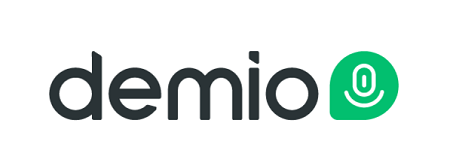



Hey, great article but there are a few cons missing. Demio doesn’t give you registration page conversion analytics (i.e you don’t know how many people didn’t register), Easywebinar requires mobile users to download the app to join a webinar AND Livestorm doesn’t show offers during webinar replay, Reminder emails outgoing time can’t be customized (1hr, 5 mins) and attendees can’t open offer pop-ups again after closing
Hi Lotanna,
Thank you for your feedback, we will look into it and update as needed 🙂